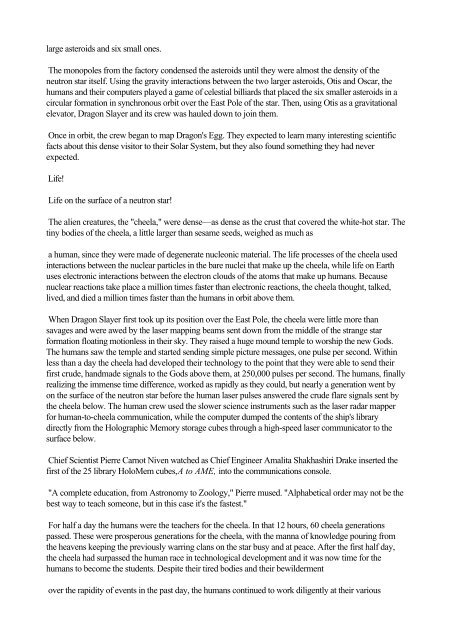You also want an ePaper? Increase the reach of your titles
YUMPU automatically turns print PDFs into web optimized ePapers that Google loves.
large asteroids and six small ones.<br />
The monopoles from the factory condensed the asteroids until they were almost the density of the<br />
neutron star itself. Using the gravity interactions between the two larger asteroids, Otis and Oscar, the<br />
humans and their computers played a game of celestial billiards that placed the six smaller asteroids in a<br />
circular formation in synchronous orbit over the East Pole of the star. Then, using Otis as a gravitational<br />
elevator, Dragon Slayer and its crew was hauled down to join them.<br />
Once in orbit, the crew began to map Dragon's Egg. They expected to learn many interesting scientific<br />
facts about this dense visitor to their Solar System, but they also found something they had never<br />
expected.<br />
Life!<br />
Life on the surface of a neutron star!<br />
The alien creatures, the "cheela," were dense—as dense as the crust that covered the white-hot star. The<br />
tiny bodies of the cheela, a little larger than sesame seeds, weighed as much as<br />
a human, since they were made of degenerate nucleonic material. The life processes of the cheela used<br />
interactions between the nuclear particles in the bare nuclei that make up the cheela, while life on Earth<br />
uses electronic interactions between the electron clouds of the atoms that make up humans. Because<br />
nuclear reactions take place a million times faster than electronic reactions, the cheela thought, talked,<br />
lived, and died a million times faster than the humans in orbit above them.<br />
When Dragon Slayer first took up its position over the East Pole, the cheela were little more than<br />
savages and were awed by the laser mapping beams sent down from the middle of the strange star<br />
formation floating motionless in their sky. They raised a huge mound temple to worship the new Gods.<br />
The humans saw the temple and started sending simple picture messages, one pulse per second. Within<br />
less than a day the cheela had developed their technology to the point that they were able to send their<br />
first crude, handmade signals to the Gods above them, at 250,000 pulses per second. The humans, finally<br />
realizing the immense time difference, worked as rapidly as they could, but nearly a generation went by<br />
on the surface of the neutron star before the human laser pulses answered the crude flare signals sent by<br />
the cheela below. The human crew used the slower science instruments such as the laser radar mapper<br />
for human-to-cheela communication, while the computer dumped the contents of the ship's library<br />
directly from the Holographic Memory storage cubes through a high-speed laser communicator to the<br />
surface below.<br />
Chief Scientist Pierre Carnot Niven watched as Chief Engineer Amalita Shakhashiri Drake inserted the<br />
first of the 25 library HoloMem cubes,A to AME, into the communications console.<br />
"A complete education, from Astronomy to Zoology," Pierre mused. "Alphabetical order may not be the<br />
best way to teach someone, but in this case it's the fastest."<br />
For half a day the humans were the teachers for the cheela. In that 12 hours, 60 cheela generations<br />
passed. These were prosperous generations for the cheela, with the manna of knowledge pouring from<br />
the heavens keeping the previously warring clans on the star busy and at peace. After the first half day,<br />
the cheela had surpassed the human race in technological development and it was now time for the<br />
humans to become the students. Despite their tired bodies and their bewilderment<br />
over the rapidity of events in the past day, the humans continued to work diligently at their various













